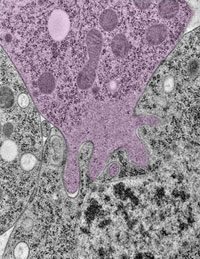Trillions of microorganisms inhabit us—inside and out. Scientists are surveying these microbial metropolises to learn more about their role in health. Microbiologists Darren Sledjeski of NIGMS and Andrew Goodman ![]() of Yale University share a few details of what researchers have learned so far.
of Yale University share a few details of what researchers have learned so far.

Researchers are surveying the microbes that inhabit us to learn more about their role in health. Credit: Andrew Goodman, Yale University.
- The majority of the microbes that inhabit us are bacteria. The rest of the microbial menagerie is fungi and viruses, including ones that infect the bacteria! Collectively, our resident microorganisms are referred to as the human microbiota, and their genomes are called the human microbiome.
- Our bodies harbor more bacterial cells than human ones. Even so, the microbiota accounts for less than 3 percent of a person’s body mass. That’s because our cells are up to 10,000 times bigger in volume than bacterial cells.
- Your collection of bacteria has more genes than you do. Scientists estimate that the genomes of gut bacteria contain 100-fold or more genes than our own genomes. For this reason, the human microbiome is sometimes called our second genome.
- Most of our microbes are harmless, and some are helpful. For example, harmless microbes on the skin keep infectious microbes from occupying that space. Microbes in the colon break down lactose and other complex carbohydrates that our bodies can’t naturally digest.
- Different microbes occupy different parts of the body. Some skin bacteria prefer the oily nooks near the nose, while others like the dry terrain of the forearm. Bacteria don’t all fare well in the same environment and have adapted to live in certain niches. The NIGMS Findings Magazine article Body Bacteria: Exploring the Skin’s Microbial Metropolis shows what types of bacteria colonize where.

- Each person’s microbiota is unique. The demographics of microbiota differ among individuals. Diet is one reason. Also, while a type of microbe might be part of one person’s normal microbial flora, it might not be part of another’s, and could potentially make that person sick.
- Host-microbial interactions are universal. Microbial communities may vary from person to person, but everyone’s got them, including other creatures. For this reason, researchers can use model organisms to tease apart the complexities of host-microbial interactions and develop broad principles for understanding them. The mouse is the most widely used animal model for microbiome studies.
- The role of microbiota in our health isn’t entirely clear. While it’s now well accepted that the microbial communities that inhabit us are actively involved in a range of conditions—from asthma to obesity—research studies have not yet pinpointed why or how. In other words, the results may suggest that the presence of a bacterial community is associated with a disease, but they don’t show cause and effect.
- Most of our microbes have not been grown in the lab. Microbes require a certain mix of nutrients and other microbes to survive, making it challenging to replicate their natural environments in a petri dish. New culturing techniques are enabling scientists to study previously uncultivated microbes.
- The impact of probiotic and prebiotic products isn’t clear. Fundamental knowledge gaps remain regarding how these products may work and what effects they might have on host-microbial interactions. A new NIH effort to stimulate research in this area is under way.
- There’s even more we don’t know! Additional areas of research include studying the functions of microbial genes and the effects of gut microbes on medicines. The more we learn from these and other studies, the more we’ll understand how our normal microbiota interacts with us and how to apply that knowledge to promote our health.



